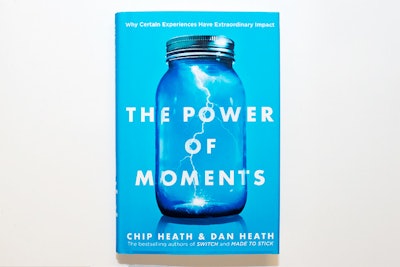
One of the underlying goals planners strive to achieve—whether producing a trade show, gala, or conference—is to create an event that is meaningful and memorable for attendees. In a new book that comes out today, The Power of Moments: Why Certain Experiences Have Extraordinary Impact, authors and brothers Chip and Dan Heath present dozens of examples that show how carefully crafted moments within an event can be the key to creating that long-term impact.
“When we take a vacation, we don’t remember the filmstrip of the vacation. What we remember are the snapshots, moments that were strongly emotional or touching or connected us with our kids or our spouse,” says Chip Heath. “I think the whole notion of 'customer journey mapping' [or trying to think through every step of a customer's journey, for example at an event or in a retail environment] is flawed because it acts as if every moment matters and matters equally. That’s just not true.”
The challenge for planners and others who may have to justify the business expense of creating these “defining moments” is that from a purely budgetary perspective, they may seem extravagant. In the book, the Heaths share the example of the Magic Castle, a top-rated hotel in Los Angeles. Heath says one of the reasons the modest hotel is so beloved by guests is thanks to its Popsicle Hotline, which summons a gloved staffer to deliver popsicles on a silver tray to the pool deck any time of day.
“That’s a moment,” he says. “But it’s exactly the kind of thing an accountant or operations manager might look at and ask, ‘Why not just put them in a cooler by the pool and let people self-serve?’ Or they might say ‘Why popsicles? Let’s just do lollipops.’ Very quickly a moment gets rationalized by most organizations down to something that’s no longer emotionally stunning; it’s just efficient.”
The hotel’s Popsicle Hotline is an example of “elevation,” one of the Heaths’ elements of a memorable, positive moment. “Any time we can create strongly visceral experiences, that’s a good thing,” he says.
Another critical element, with clear application for planners, is “connection.” One of the simplest ways planners can facilitate connection is by creating opportunities for attendees to have conversations that go beyond a superficial level. “We talk about networking, but we often leave those moments to chance,” he says. “We may plan the elevation elements of the experience—the beautiful venue, the great food, the striking musical entertainment—[because] we’re thinking consciously about those, but we are not thinking about engineering the networking effect.”
Two other principles that the authors discuss in the book are “pride”—celebrating the things that make a group distinctive—and “insight”—providing meaningful content.
For planners struggling to get buy-in—and budgets—the authors cite research from Forrester about the value of creating experiences that elevate the opinion of customers who are neutral or mildly positive. “There is nine times more revenue available for making people who are kind of okay with your product or service into big fans,” Heath says, versus what's spent on trying to move those who are dissatisfied into a neutral position.
“And yet companies spend 80 percent of their time solving complaints," he continues, "As opposed to asking 'How do we take people who are okay and make them wildly positive?' This is an opportunity that’s ripe for any organization."

















